Once you have replaced your alternator belt and drive home, you sigh in relief. Then, unfortunately, you hear this annoying squealing that gets worse as the car idles on the way home. While this is a common occurrence, you should understand what’s happening.
Here we will look at why the alternator belt squeals after replacement, solutions, and five methods to fix the problem!
Reasons Why Alternator Belt Squeals After Replacement
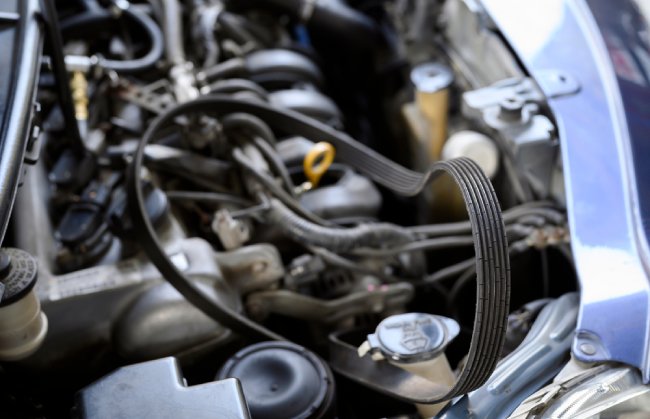
1. Bad hydraulic belt tensioner
A shock absorber controls the hydraulic belt tensioner. The tensioner itself keeps the drive belt in place—the alternator belt squeals when the tensioner isn’t working correctly and is too tight or loose. You can hear the squeals when making a turn and when the car idles.
Solution:
Look at the tensioner before repairing it. It is a tricky job; if you have not done it before, you may want to have a mechanic take care of it. You can damage the engine if done incorrectly.
2. Belt misaligned from improper installation
An improperly installed belt will squeal since the serpentine belt requires great tension. Have your mechanic recheck the belt and readjust the tensioner. It’s not suitable for your ears or the belt to squeal incessantly.
Solution:
Before starting, if you are unsure how the serpentine belt routes on the pulley, find the diagram in the owner’s manual.
Use a ratchet and socket, loosen the tensioner pulley nut and rotate the arm as far as it will go to release the belt. Slowly turn the tensioner bar as you put on the belt, wrapping around the crankshaft pulley, onto a grooved pulley.
Then check the manual onto the non-grooved pulley for placement. Release the tensioner slowly and replace the bolt. Once complete, start the car and check for squealing.
3. Worn pulley/incorrect pulley alignment
If the grooves on the serpentine belt are not aligned with the pulley grooves, it may squeal. The serpentine belt is attached to the pulley so it can turn along with other belt-driven parts of the engine.
Solution:
Shut off the car. You can repair this by loosening the tension adjustment bolt. Then turn the pulley to lessen the tension. Next, while pivoting the pulley outward, adjust the tension.
Finally, reseat the serpentine belt. Once you achieve the correct tension, retighten the adjustment tension bolt
4. Idler pulley
If the serpentine belt is in good condition and not too dry, the idler pulley is the problem. Some belts connect to the idler’s crankshaft—this helps run the AC compressor, your power steering pump, and alternator.
However, it can shift and create the squealing you hear without the correct tension on the serpentine belt.
Solution:
A mechanic can check the idler pulley’s tension and check for faulty bearings in the idler.
5. Dry/worn alternator serpentine belt
Serpentine belts need replacing about every 75,000 miles. Worn-out belts can’t maintain the tension to hold the tensioner pulley that links the belt together.
When the pulley and belt slip, they squeal loudly. Periodically, you should check the belts for cracks and ensure it is not dry rotting.
Solution:
The only solution for dried, cracked, and worn belts are to replace them. If you need a how-to for this procedure, continue to read below in the methods section.
6. The belt is too loose
A loose belt doesn’t work correctly and squeals…shrilly.
Solution:
You can adjust the belt by loosening the pulley nut, then adjusting the tensioner. First, tighten the belt until the squealing stops. Then retighten the pulley nut.
7. Idler pulley faulty/Tensioner bearing
Tensioner bearings keep the belt spinning correctly (generally in a one-belt vehicle)—the bearings house inside the idler pulleys. You can hear the squeals or whirring noise when the bearings aren’t working. This noise can be hard to hear and locate.
Solution:
To replace the idler pulley, you have to remove the belt, replace the idler, and put the belt back on.
8. Colder weather
Cold weather is hard on belts, making them brittle and crack easier. Take note of when the belt is squealing.
Solution:
If it squeaks when the engine is cold and stops as the engine warms up, the belt is probably fine. However, if it squeaks after the engine is warm, you should have a mechanic check it out to be safe.
9. Contamination from oil
If the non-ribbed side of the belt looks shiny or oily, there is contamination with oil. Oil will break down the belt material and compromise how it operates. There is also concern that you have an oil leak somewhere that needs looking into.
Solution:
Loosen the bolt on the tensioner pulley, and rotate the tensioner arm. Then remove the belt and place the new one on using the diagram in the owner’s manual for placement. Now install the new belt, and rotate and retighten the pulley belt.
10. Coolant exposure
Antifreeze is corrisve to the drive and serpentine belts. Once it soaks into the belt, it is damaged. While belt dressing can quiet the squeals, the damaged belt needs fixing before further hurting the engine.
Solution:
Finding the coolant leak and fixing it will stop future coolant damage to your belts. The contamination ruins the belt and it needs replacing. Use the steps in #10 to replace the belt
11. Bad spring-loaded tensioner
While you drive, the alternator belt is adjusted by a spring in the spring-loaded tensioner. If the tensioner malfunctions by rocking back and forth, it will cause the alternator belt to pop off at times, and you will hear squealing.
Solution:
Replacing the tensioner is the best solution because the belt tension needs to be perfect.
Stop the Alternator Belt From Squealing
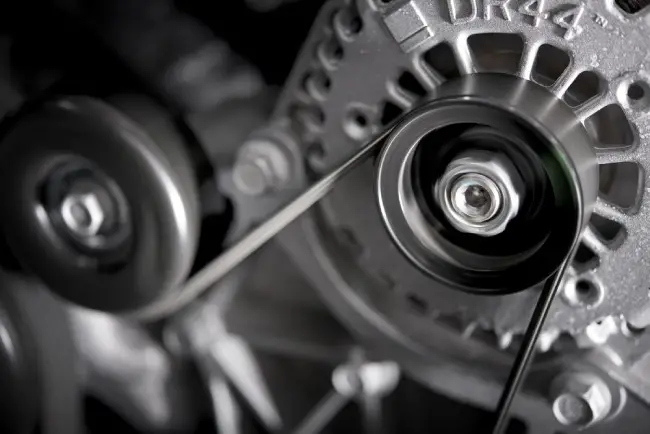
-
Method 1: Stopping the serpentine squeal
Step 1: Raise the hood after starting your car. Then, using a flashlight, find the belt’s ribbed side where it will go under the pulley and spray enough WD-40 to cover the belt lightly. If you listen and look at the belt, you may be able to find the exact spot where the belt starts to squeal.
Step 2: Over spraying the belt can severely damage the belt and create slipping. You want enough WD-40 on there to remove the moisture causing the squeal.
Give the engine a few minutes to run, spray the rubber dressing lightly, and continue letting the engine run until the squeal is completely gone.
Step 3: If the squeal stops and restarts or never leaves, the belt is glazed and can no longer grip the pulleys. The only solution is to replace the belt.
-
Method 2 Adjusting the tensioner
Step 1: Loosen the pulley nut.
Step 2: Adjust the tensioner until you eliminate the squealing, so you won’t have to over-tighten the tensioner or calculate deflection mm’s.
Step 3: After the tensioner is adjusted, retighten the pulley nut.
-
Method 3: Use bar soap to fix a squeaky belt
This method is a temporary fix and not really effective.
Step 1: Make sure the engine is not running.
Step 2: Rub the soap on the parts of the belt you can see and reach.
Step 3: Give the soap a few minutes, then restart the car to make sure the squeal is gone.
-
Method 4: Defective pulley bearing replacement
Step 1: Use a ½-inch impact wrench, and remove the pulley bearing nut while holding the pulley bearing in place with a channel lock.
Step 2: Once the nut is off, remove the pulley bearing
Step 3: Place the replacement pulley bearing in the alternator and replace the washer and nut on the pulley. Hand-tighten the nut.
Step 4: Tighten the nut snugly but do not overtighten. Check the manual for the vehicle-specific torque recommendations and tighten it to that spec.
-
Method 5: Using belt dressing for squealing
Step 1: Read the directions on the belt dressing (belt conditioner).
Step 2: While the car is running, lightly spray the belt dressing on each side of the serpentine belt.
Step 3: Listen for the squealing to stop. If the squealing restarts or does not disappear. Take the car to a mechanic.
FAQs
1. Can I drive with a squeaky belt?
Ans. If you need to use the car, do so with caution. A mechanic will need to check the belt and replace it before it damages the engine. The noise is annoying but not harmful to the vehicle.
2. Can I use WD-40 in the squeaky belt?
Ans. There are better choices to fix the squeaky belt. While it does stop the squeaking for a short time, WD-40 is corrosive to rubber and can damage the belts, wiring, other engine components, and the bearings. It is a temporary fix at best.





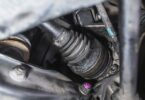

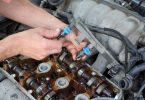
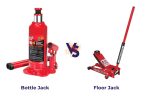

Leave a Comment